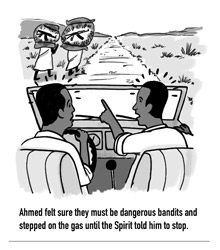 As they bumped along the rutted dirt track, they came upon two elderly men walking with large burdens wrapped in blankets on their shoulders. But Ahmed didn’t slow down; in fact, he stepped on the accelerator, hard. It was not uncommon to be waylaid by criminals brandishing AK-47s, and Ahmed was in no mood to take any chances.
As they bumped along the rutted dirt track, they came upon two elderly men walking with large burdens wrapped in blankets on their shoulders. But Ahmed didn’t slow down; in fact, he stepped on the accelerator, hard. It was not uncommon to be waylaid by criminals brandishing AK-47s, and Ahmed was in no mood to take any chances.They were about two hundred kilometers from a region where a special person named Maysa lived. She was a was a very ordinary person, traveling with her husband and livestock around the the countryside with groups of other nomads looking for grazing areas for the animals. The couple were both Christians, alone in an area where everyone else was Muslim. Maysa had attended a training seminar offered by a missions organization, in which she learned how to tell stories from the Bible, beginning at creation and moving forward chronologically toward Christ. As soon as she rejoined her family, Maysa began sharing these stories with other nomadic women. That was just one year ago.
As soon as Ahmed and Mechela roared past the elderly men in a cloud of dust, the Holy Spirit pressed Ahmed as hard as he had pressed the gas pedal. Ahmed felt instantly convicted that he had made a poor choice, and he found himself easing off the gas and stepping on the brake.
The elderly men clambered into the backseat, bowing and grinning to the Christians in the front as they dumped their burdens, from which no firearms appeared, onto the floor. Mechela breathed a sigh of relief.
Soon they were chatting together. Mechela asked, “Would you like to hear a story?” he asked. There were no radio stations in the desert, and storytelling was a good way to pass the time, so the men readily agreed, “Well” continued Mechela, getting comfortable in his reversed position on the front seat, ‘do you know where the whole world came from? It was like this: in the beginning… .” He had not gotten more than a minute into his story when he was abruptly interrupted. “Oh, we already know that story!” cried the hitchhikers in unison.
Poor Mechela was taken aback once again. He stared at his new friends with open mouth, too surprised to speak, so Ahmed rescued him by asking the men to tell their own story of creation. And they proceeded to recite it verbatim according to the way his missions team taught the Scriptures to those who could not read. As the men began to tell Mechela and Ahnied the story of Noah, Ahmed asked them, “Excuse me, but where did you learn these stories?”
“Last rainy season,” the men answered, “a man moved to our village and taught us these stories and many others. Let us tell you about the great Flood... and we have many other stories that we would like to tell you.”

It took the remainder of the trip, but Ahmed and Mechela eventually were able to piece things together. They traced the source of the Bible stories that the men had learned all the way back to Maysa and her husband, who had led others to become disciples of Christ, who in turn had gone to distant villages and shared the gospel with more nomads. These two elderly men, hitchhiking their way through the desert, were the fifth generation of Christ followers growing out of Maysa’s efforts, and they were on their way to share the gospel with a young couple who would soon be married and would carry it on to others. And all this took place in the space of one year!
This spreading of the gospel through the desert, one person sharing Scripture stories with another outside of any formal setting, is what Ahmed and his team call “the church on the camel’s path.”
(excerpted from Jerry Trousdale, Simple Churches: Dramatic Transformations, Rapid Replication, Mission Frontiers, Sep/Oct 2012)
(To receive new uMarko posts via a daily email, please click Subscribe)



 cm.
cm. 


